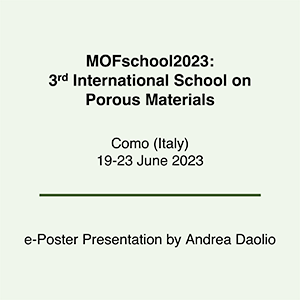Como (Italy), 19-23 June 2022, e-Poster Presentation by Andrea Daolio
Title: “Dynamics of Dipolar Molecular Rotors in Fluorinated Byciclopentane-Based MOFs”
Authors: A. Daolio, J. Perego, C. X. Bezuidenhout, S. Bracco, S. Piva, G. Prando, C. Aloisi, P. Carretta, J. Kaleta, T. P. Le, P. Sozzani and A. Comotti
Abstract
The study of motion in solids is a particularly timely topic. The fabrication of materials such as Metal-Organic Frameworks (MOFs) provide a robust, yet often flexible, scaffold with excess free volume where embedded molecular switches, motors and rotors are free to move[1]. In turn, functional properties can be then imposed or modulated by controlling the rotation of said moieties inside the framework[2]. Namely, MOFs embedded with dipolar molecular rotors are emerging as an interesting class of compound for their ability to respond to static or oscillating electric fields. In this work, we selected a bicyclopentanedicarboxylate-based (FTR) aluminium MOF (Al-FTR) and its dipolar, fluorinated analogue (Al-FTR-F2) to study the motion of these ligands at very low temperatures[3]. Computationally-informed structural analysis (PXRD, synchrotron-source) of the two MOFs reveals unusual, extensive dynamics down to temperatures as low as 2 K, reminiscent of liquid state mobility. Notably, the mobility in Al-FTR-F2, especially at those extreme temperatures, is due to a concerted dance of dipoles triggered by the interactions among nearest-neighbour rotors, which interconvert into each other thanks to a cascade mechanism. The subsequent study of the CO2-filled Al-FTR-F2 is then carried out in order to induce a coherence switch of the dipolar rotors, drastically impacting the overall configurational landscape.Similar compounds endowed with such controllable motional phenomena may find application in sensing or switching, the translation of light irradiation into movement and the control of solid-state dynamics with electrical fields minimizing energy dissipation. [1] J. Perego, S. Bracco, C. X. Bezuidenhout, G. Prando, P. Carretta, A. Comotti, P. Sozzani. Nature Chem. (2020), 12, 845. [2] J. Perego, C. X. Bezuidenhout, S. Bracco, G. Prando, L. Marchiò, M. Negroni, P. Carretta, P. Sozzani, A. Comotti. J. Am. Chem. Soc. (2021), 143, 13082. [3] J. Perego, C. X. Bezuidenhout, S. Bracco, S. Piva, G. Prando, C. Aloisi, P. Carretta, J. Kaleta, T. P. Lee, P. Sozzani, A. Daolio, A. Comotti. Angew. Chem. Int. Ed. (2023), 62, e202215893.

